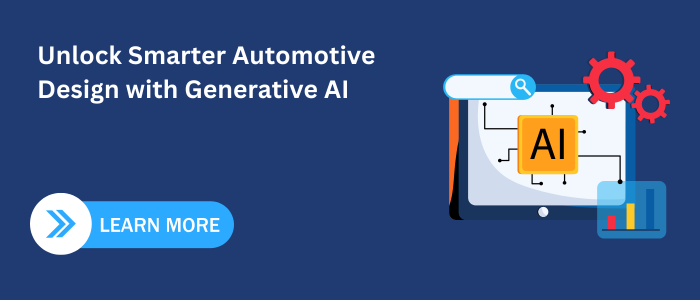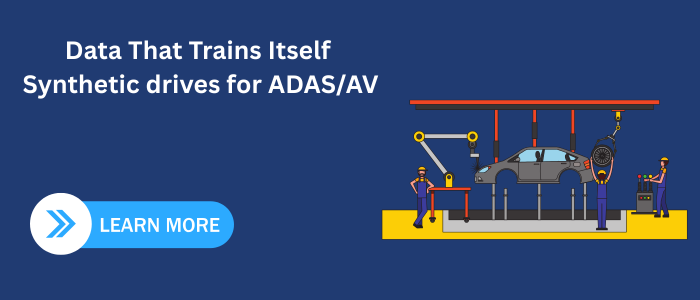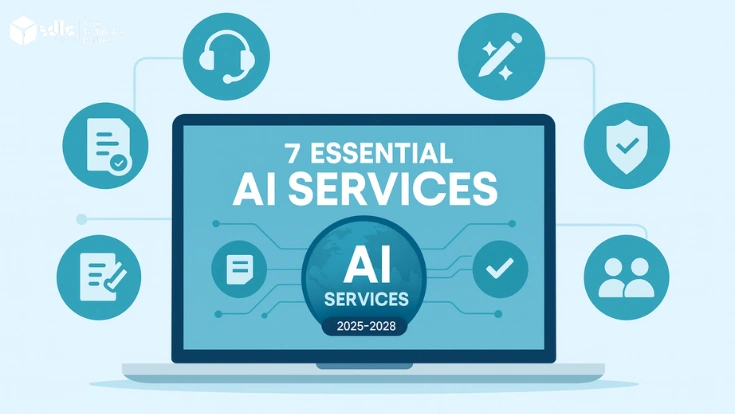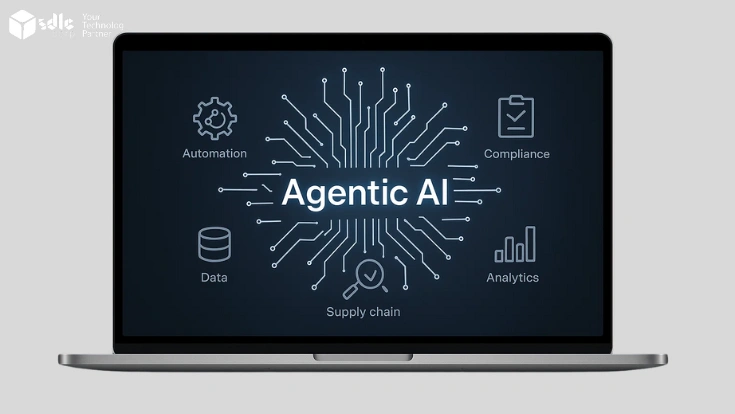Introduction
The automotive industry is undergoing a profound digital transformation, and Generative AI is emerging as one of the most powerful drivers of this change. Unlike traditional AI, which primarily analyzes historical data to make predictions, generative AI can create new outputs from car designs and traffic simulations to predictive maintenance insights. This capability enables automakers to accelerate development cycles, optimize performance, reduce costs, and improve safety across the automotive value chain.
From conceptual vehicle design and advanced driver-assistance systems (ADAS) to predictive maintenance and manufacturing optimization, generative AI is transforming how vehicles are engineered, built, and maintained. As an AI development company, we’ve observed that organizations leveraging generative AI speed up product cycles and maintain compliance with regulatory standards while delivering smarter, more sustainable mobility solutions.
What is Generative AI in Automotive?
Generative AI refers to machine learning models that can produce new outputs based on patterns learned from existing data. Unlike predictive AI, which forecasts outcomes or classifies data, generative AI creates realistic, actionable results that directly influence design, engineering, and operations.
Role of Generative AI in Automotive Operations
Automotive organisations manage complex data across design, manufacturing, vehicle software, and after-sales systems. Generative AI can support these operations by summarising technical documentation, analysing maintenance records, and assisting with internal knowledge sharing. In many cases, teams work with a Generative AI consulting company to evaluate where generative models add value while maintaining safety and compliance standards.
Use of Generative AI in Automotive Systems
Automotive platforms generate data across design, manufacturing, vehicle operation, and after-sales support. Generative AI can assist by summarising engineering documents, analysing sensor data reports, and supporting internal knowledge systems. Many teams explore Generative AI development services to build models that work alongside automotive data standards and system constraints.
Key Generative AI Techniques in Automotive
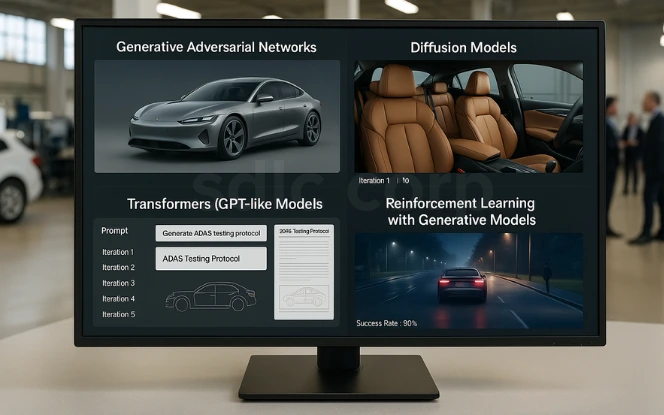
- Generative Adversarial Networks (GANs):
Used for generating realistic vehicle prototypes, interiors, and road scenarios. GANs simulate variations in design, lighting, and materials, helping visualize concepts before physical prototyping. - Diffusion Models:
Produce high-quality visuals for vehicle concepts, interior styling, and marketing visualizations. Designers can explore multiple iterations rapidly and cost-effectively. - Transformers (e.g., GPT-like models):
Assist in generating technical documentation, testing protocols, simulation reports, and driver-assist algorithms. Transformers accelerate reporting and standardize documentation. - Reinforcement Learning with Generative Models:
Generates adaptive strategies for autonomous vehicle navigation by simulating rare or extreme driving scenarios to test decision-making algorithms. - Design, Testing, and Manufacturing Support: Vehicle development involves extensive testing, documentation, and design iteration. Generative AI can help draft test reports, generate simulation summaries, and support design reviews. In these scenarios, a Generative AI consulting company may help assess feasibility, define review processes, and ensure outputs remain aligned with safety and compliance requirements.
Applications of Generative AI in Automotive
Vehicle Design and Prototyping
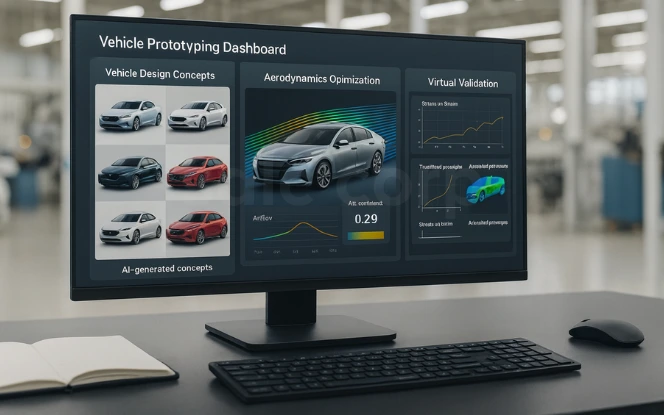
Generative AI is applied at nearly every stage of the automotive lifecycle, enhancing design, manufacturing, autonomous driving, and after-sales services.
- Generate multiple car design concepts in hours instead of months.
- Optimize aerodynamics using AI-driven Computational Fluid Dynamics (CFD) simulations.
- Reduce reliance on costly physical prototypes through virtual validation of designs.
Autonomous Driving and ADAS Simulation
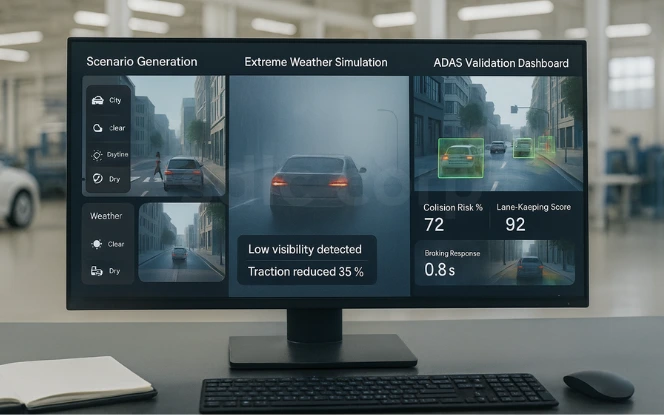
- Create rare or dangerous driving scenarios, such as sudden pedestrian crossings or extreme weather conditions.
- Train autonomous systems with synthetic datasets to cover edge cases and blind spots.
- Validate ADAS algorithms under controlled yet diverse virtual environments.
Predictive Maintenance and After-Sales
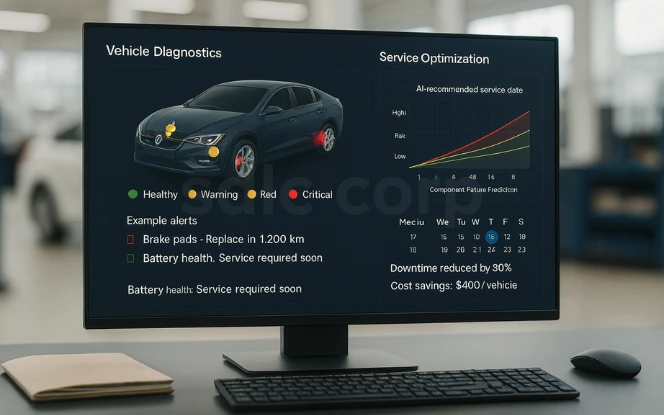
- Forecast component failures and recommend preventive interventions.
- Optimize service schedules to minimize vehicle downtime and warranty costs.
- Provide customers with AI-generated maintenance insights through mobile apps.
Manufacturing Optimization
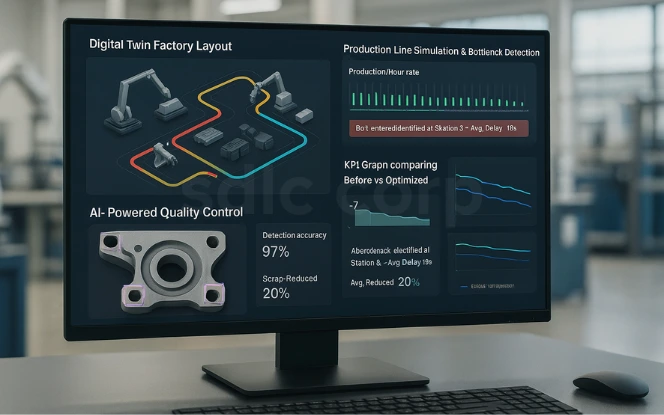
- Automate factory layouts and production line simulations.
- Predict bottlenecks in assembly lines and suggest workflow improvements.
- Enhance quality control using generative models for defect detection and process optimization.
Supply Chain and Logistics
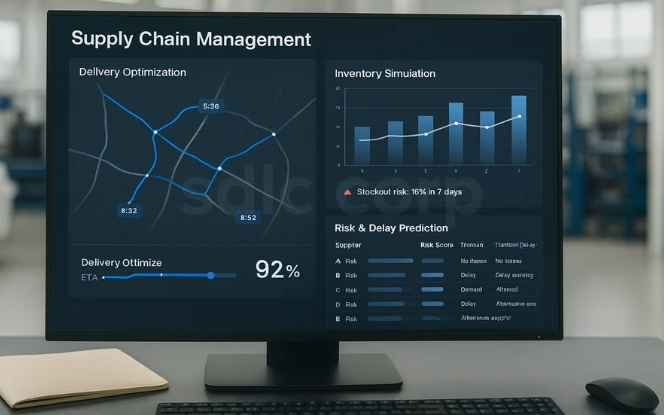
- Generate optimized delivery schedules based on predictive modeling.
- Simulate inventory requirements under fluctuating market and supply conditions.
- Predict supplier risks and transportation delays to minimize downtime.
Implementation in the Automotive Industry
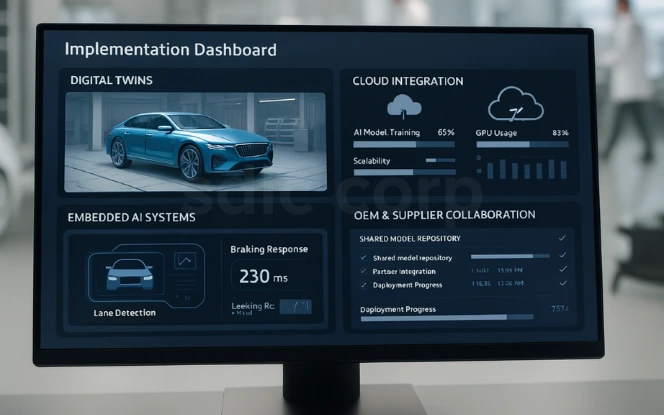
Transforming generative AI applications into practical solutions requires a careful strategy and robust infrastructure. Key implementation approaches include:
- Digital Twins: Virtual replicas of vehicles and factories simulate performance, wear-and-tear, and production workflows before physical rollout.
- Cloud Integration: High-performance cloud platforms enable training of large generative AI models, ensuring scalability and faster experimentation.
- Embedded AI Systems: Lightweight generative models can be deployed in ECUs (Electronic Control Units) to enable real-time decision-making.
- OEM & Supplier Collaboration: Automakers partner with AI development companies to integrate pre-trained models for faster and cost-effective deployment.
Benefits of Generative AI in Automotive
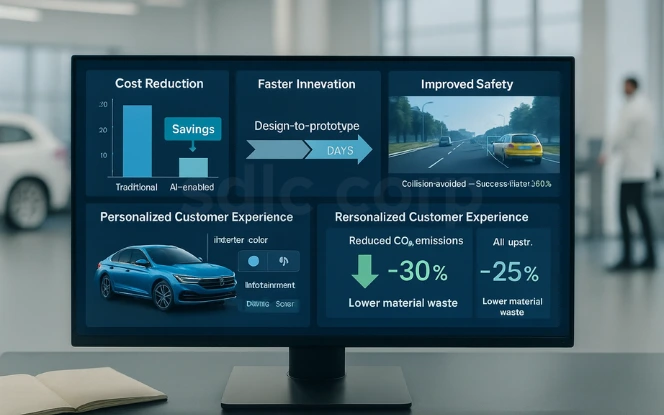
- Cost Reduction: Fewer physical prototypes and optimized operations lead to significant savings.
- Faster Innovation: Design and simulation cycles shrink from months to days.
- Improved Safety: AI-generated scenarios ensure autonomous and ADAS vehicles perform reliably under extreme conditions.
- Personalized Customer Experience: Vehicles can be tailored to individual preferences, enhancing brand loyalty.
- Sustainability: Reduced waste in manufacturing and optimized logistics lowers environmental impact.
Challenges and Considerations
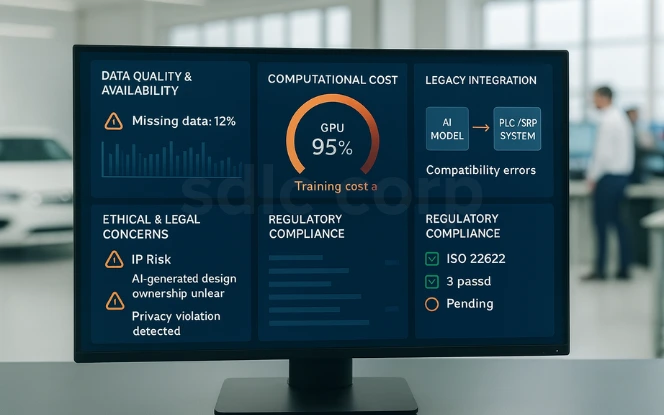
While generative AI offers immense benefits, adoption in automotive comes with hurdles:
- Data Quality & Availability: Large, high-quality datasets are essential for accurate AI models.
- Computational Cost: Generative AI models demand significant computing resources.
- Integration with Legacy Systems: Many factories rely on older infrastructure, complicating deployment.
- Ethical & Legal Concerns: Ownership of AI-generated designs, intellectual property, and data privacy remain sensitive issues.
- Regulatory Compliance: Compliance with standards like ISO 26262 is mandatory for functional safety.
Future of Generative AI in Automotive
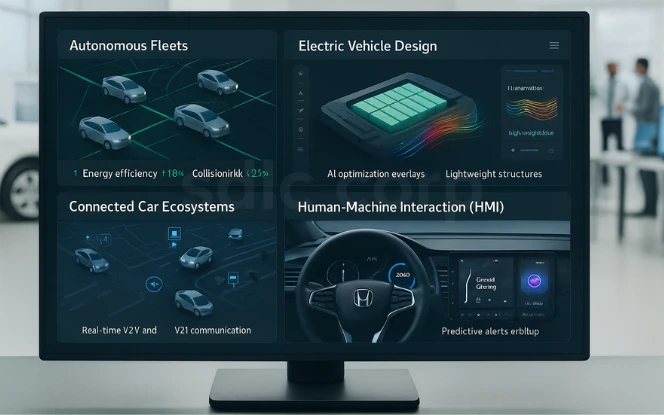
The next decade will see generative AI expand into:
- Autonomous Fleets: Continuous AI-driven improvements in navigation, energy efficiency, and passenger safety.
- Electric Vehicle Design: Optimized battery layouts, aerodynamics, and lightweight structures.
- Connected Car Ecosystems: Real-time vehicle-to-infrastructure and vehicle-to-vehicle communication powered by AI.
- Human-Machine Interaction (HMI): Adaptive in-car experiences based on driver behavior, preferences, and predictive analytics.
Automakers investing early in ethical AI practices and robust infrastructure will lead the next era of mobility innovation.
Conclusion
Generative AI is transforming the automotive sector with breakthroughs in design, autonomous driving, predictive maintenance, manufacturing, and supply chain optimization. By enabling faster innovation, reducing costs, and improving safety, it sets the foundation for next-generation mobility solutions.
As vehicles evolve toward connectivity, electrification, and autonomy, early adoption of generative AI gives a competitive edge. Organizations looking to implement custom AI solutions can hire generative AI developers to accelerate innovation and achieve measurable results.
Related Blogs You Should Explore:
FAQ's
What Is Generative AI In The Automotive Industry?
Generative AI creates new outputs like vehicle designs, road scenarios, or synthetic datasets. It helps in design, simulation, and predictive analytics across automotive workflows.
How Does Generative AI Help In Vehicle Design?
It generates multiple design options considering safety, aerodynamics, and materials. This reduces prototypes, speeds up R&D, and supports innovative EV designs.
How Does Generative AI Improve Autonomous Driving And Adas?
By simulating rare or extreme driving scenarios, generative AI trains ADAS and self-driving systems to handle unpredictable conditions safely.
Can Generative AI Reduce Costs In Automotive Manufacturing?
Yes, it optimizes assembly lines, minimizes defects, and reduces waste, resulting in lower production costs and higher operational efficiency.
What Role Does Generative AI Play In Predictive Maintenance?
It analyzes sensor data, simulates failure scenarios, and recommends preventive measures, reducing breakdowns and warranty claims.
What Challenges Exist In Adopting Generative Ai In Automotive?
Key challenges include high computational costs, data quality, integration with legacy systems, and compliance with safety standards.
Is Generative AI Safe And Reliable For Vehicles?
Yes, with rigorous validation and a combination of synthetic and real-world data, generative AI can reliably enhance vehicle safety and performance.

